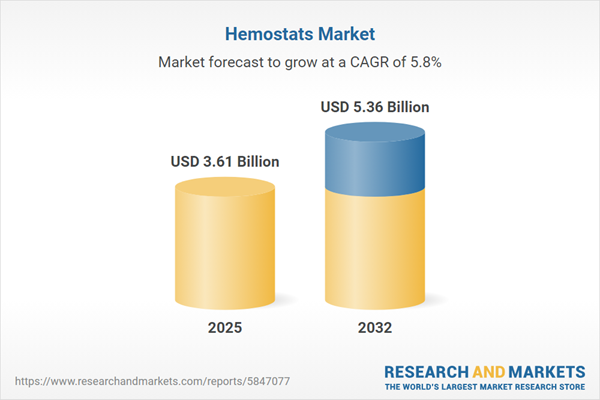Speak directly to the analyst to clarify any post sales queries you may have.
The hemostats market is rapidly evolving, shaped by clinical innovation, shifting procurement strategies, and the adoption of advanced hemostatic technologies. Senior decision-makers across healthcare and medical device sectors will benefit from detailed, actionable insights tailored for strategic planning and operational excellence.
Market Snapshot: Hemostats Market Growth and Opportunities
The Hemostats Market grew from USD 3.42 billion in 2024 to USD 3.61 billion in 2025. It is expected to continue growing at a CAGR of 5.78%, reaching USD 5.36 billion by 2032. This momentum reflects ongoing demand driven by advancements in surgical practices, increased procedural volumes, and the global adoption of innovative hemostatic agents. Market development is supported by robust R&D initiatives and regional healthcare investments, positioning stakeholders to benefit from strong, sustained expansion.
Scope & Segmentation in the Hemostats Market
This report provides comprehensive coverage of the hemostats market, breaking it down by product type, material, form, application, distribution channel, end user, region, and key companies. The analysis highlights technologies, sourcing strategies, and application-specific innovations vital for informed decision-making.
- Product Types: Active hemostats, combination hemostats, flowable hemostats, mechanical hemostats
- Materials: Natural products, including cellulose, chitosan, collagen, gelatin; synthetic derivatives, such as dextran, PEG, polyhemoglobin
- Form Factors: Liquid, semisolid, solid, spray forms, designed for varied surgical applications
- Surgical Applications: Cardiovascular, general, gynecological, neurological, orthopedic, and reconstructive surgery
- Distribution Channels: Offline and online—including eCommerce platforms and direct manufacturer websites
- End Users: Ambulatory surgery centers, clinics, hospitals, specialty centers
- Regions: Americas (United States, Canada, Mexico, Brazil, Argentina, Chile, Colombia, Peru), Europe, Middle East & Africa (United Kingdom, Germany, France, Russia, Italy, Spain, Netherlands, Sweden, Poland, Switzerland, United Arab Emirates, Saudi Arabia, Qatar, Turkey, Israel, South Africa, Nigeria, Egypt, Kenya), and Asia-Pacific (China, India, Japan, Australia, South Korea, Indonesia, Thailand, Malaysia, Singapore, Taiwan)
- Key Companies: Includes leading and emerging firms such as A.R. Medicom, Advamedica, B. Braun SE, Baxter International, Medtronic PLC, Johnson & Johnson Services, and others
Key Takeaways for Senior Decision-Makers
- The critical function of hemostats now spans diverse medical disciplines, supporting both minimally invasive and complex procedures, and gaining relevance beyond traditional operating rooms.
- Hybrid developments leveraging biocompatible natural materials and engineered polymers are expanding product capabilities and driving cross-sector research and regulatory cooperation.
- Market segmentation reveals opportunity through differentiated product offerings and channel diversification, particularly as online procurement and specialized clinical segments grow in prominence.
- Adoption of new manufacturing strategies and supply chain integration has heightened the focus on resilience and operational efficiency, especially in light of changing trade and tariff circumstances.
- Competitive positioning increasingly depends on targeted R&D, collaboration with clinical and academic partners, and rapid adaptation to varied regional requirements.
Tariff Impact and Domestic Production Dynamics
New tariff measures implemented in 2025 are altering the competitive landscape in the United States. Increased import duties on raw materials have forced companies to reevaluate supply chains and consider vertical integration strategies. As domestic manufacturers invest in expanded local capacity and seek alternative sourcing, these changes influence procurement costs and may delay immediate operational gains. Market consolidation and long-term shifts in sourcing strategy are expected to shape industry response going forward.
Methodology & Data Sources
Analysis is built on a structured, multi-step research process. Extensive secondary research using peer-reviewed publications, trade databases, and regulatory information was followed by primary engagement with key market stakeholders. This approach ensures reconciled, reliable data through triangulation and quality validation.
Why This Report Matters for Decision-Makers
- Guides strategic investments in product development, regulatory planning, and market access initiatives shaped by verified industry trends.
- Delivers actionable intelligence on competitive maneuvers, sourcing strategies, and clinical adoption factors—helpful for both market entry and expansion.
Conclusion
The hemostats market is marked by technological advancement, evolving regulatory policies, and new sourcing dynamics. Senior leaders equipped with these insights are well-positioned to capture growth, optimize procurement, and align operations for enduring impact.
Additional Product Information:
- Purchase of this report includes 1 year online access with quarterly updates.
- This report can be updated on request. Please contact our Customer Experience team using the Ask a Question widget on our website.
Table of Contents
3. Executive Summary
4. Market Overview
7. Cumulative Impact of Artificial Intelligence 2025
Companies Mentioned
The companies profiled in this Hemostats market report include:- A.R. Medicom, Inc.
- Advamedica Inc.
- Aegis Lifesciences Private Limited
- B. Braun SE
- Baxter International, Inc.
- Becton, Dickinson and Company
- Cotran Corporation, USA
- Dolphin Sutures by Futura Surgicare Pvt. Ltd.
- Dynarex Corporation
- Gelita Medical GmbH
- George & Georges Medisurg Limited
- Johnson & Johnson Services, Inc.
- Medline Industries, Inc.
- Medtronic PLC
- Meril Life Sciences Pvt. Ltd.
- Pfizer Inc.
- Rousselot by Darling Ingredients International Holding B.V.
- SeraSeal
- Shilpa Medicare Ltd.
- SYMATESE
- Teleflex Incorporated
- Terumo Cardiovascular Systems Corporation
Table Information
| Report Attribute | Details |
|---|---|
| No. of Pages | 181 |
| Published | November 2025 |
| Forecast Period | 2025 - 2032 |
| Estimated Market Value ( USD | $ 3.61 Billion |
| Forecasted Market Value ( USD | $ 5.36 Billion |
| Compound Annual Growth Rate | 5.7% |
| Regions Covered | Global |
| No. of Companies Mentioned | 23 |









